Introduction
Update 8/16/16 – Added better internal photos
It’s been a slow start for Broadcom’s entry into the MU-MIMO router market. The company’s 4×4 802.11ac chipset made its first appearence in super-high-end AC5300 class routers like NETGEAR’s R8500 Nighthawk X8 and ASUS’ RT-AC5300 late last year. These tri-radio routers had working "Smart Connect" automatic band-steering—although some would argue whether Smart Connect actually works—but shipped without their other key feature, MU-MIMO, enabled.
The lower cost alternative for getting Broadcom’s 4×4 chipset comes in the form of AC3100 / AC3150 class routers. These are meant to go head-to-head with AC2600 class products using Qualcomm Atheros’ 4×4 MU-MIMO technology. The only AC3100 class products to hit the shelves until now have been ASUS’ RT-AC88U and RT-AC3100. These are essentially the same router, with the difference being the number of Gigabit Ethernet LAN ports; 8 for the AC88U and 4 for the AC3100.
Which brings us to TP-Link’s Archer C3150 Wireless Dual Band Gigabit Router, the second Broadcom-based 4×4 router we’ve seen. After reviewing ASUS’ RT-AC88U, I put in place a moratorium on reviewing AC3100 / 3150 class routers, preferring to review them with working MU-MIMO. So when TP-LINK said the C3150’s MU-MIMO was working, I had them send it on in. More on that later.
The Archer C3150’s design is very much like its QCA-based sibling, the Archer C2600. At first glance, you’d be hard-pressed to tell the two apart, since TP-LINK has chosen to not include the product’s model number next to its logo on the top panel.
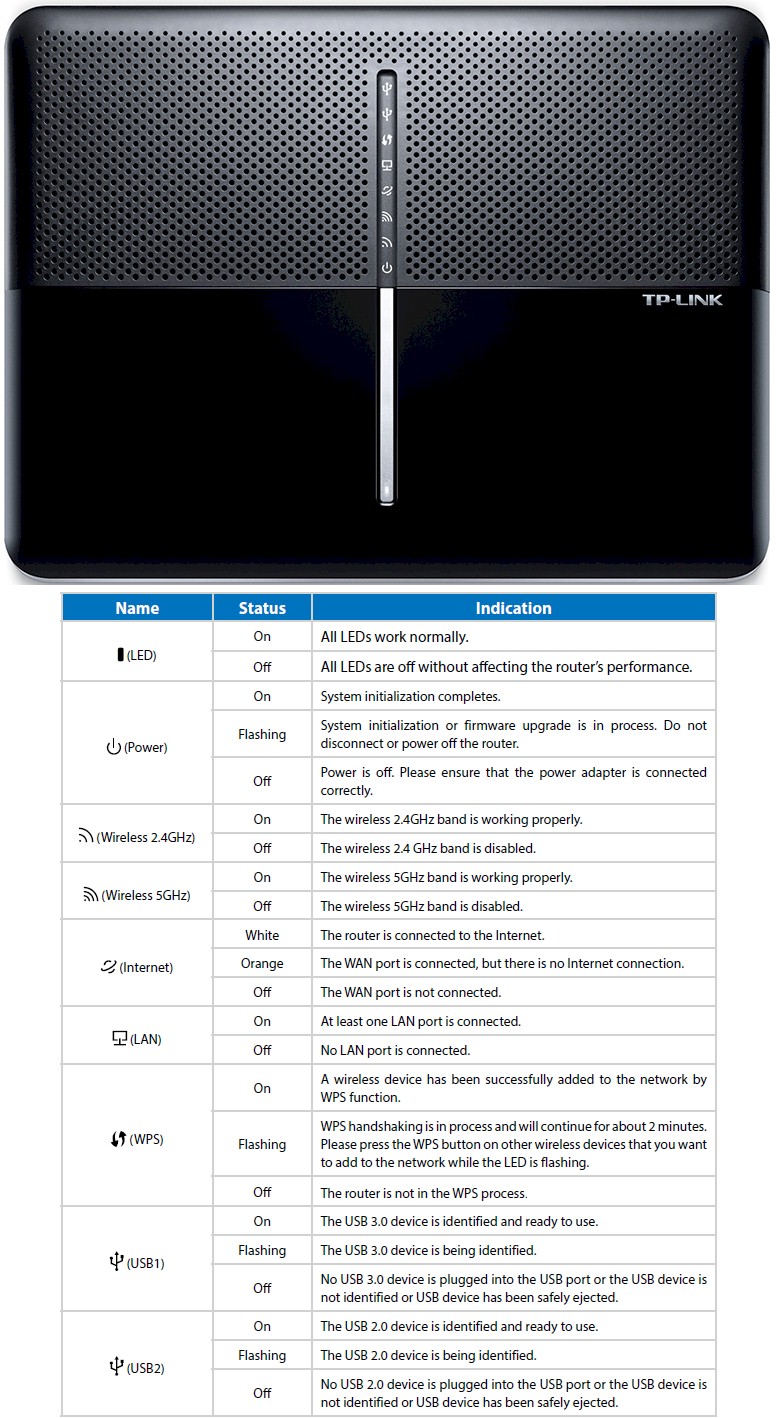
TP-LINK Archer C3150 LED callouts
The rear and side panels, however, are a different story. The positions of WAN and LAN ports are swapped, and the USB connector panel is on the left side vs. the C2600’s right. The C3150 also has one each USB 2.0 and 3.0 ports; the C2600 has two USB 3.0.
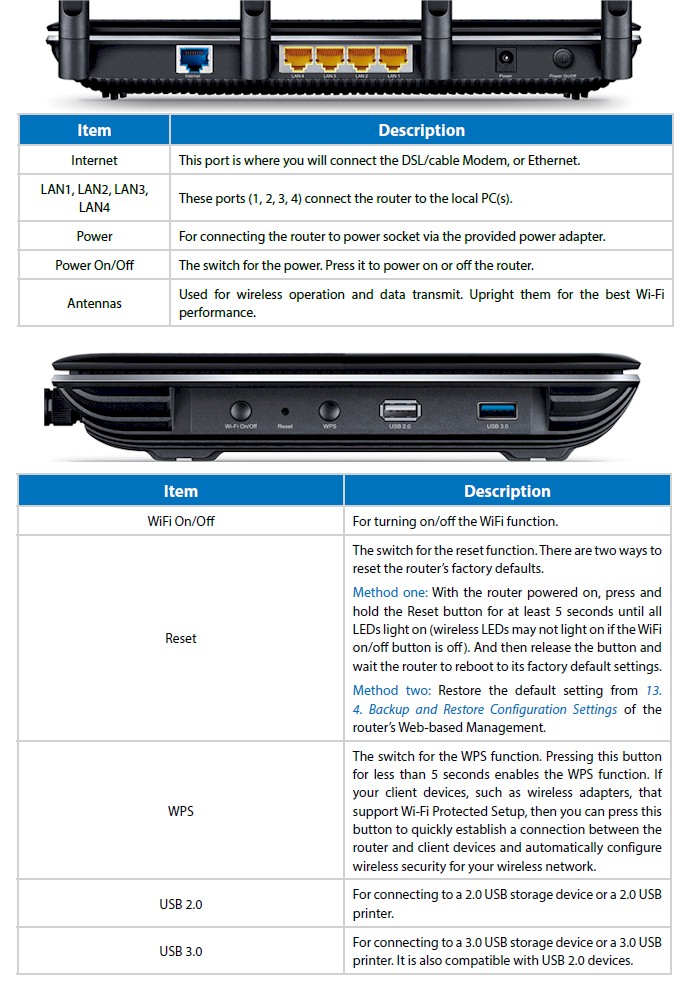
TP-LINK Archer C3150 rear & side panel callouts
The bottom and back part of the top panel of the router have plenty of vent slots. There are no vents on the sides. The C3150 is designed to sit flat on a desk, but can be wall mounted via two bottom-panel screw slots that will orient the rear panel toward the ceiling.
Inside
TP-LINK didn’t put a short-term hold on its FCC ID docs, so I didn’t have to open the router for component identification. You’ll have to excuse the fuzzy pictures; they are taken from the FCC ID document. Fortunately, the document also had close-ups of the key components for accurate identification.
The first picture shows the router cover removed. There’s one big ol’ heatsink covering all the thermally-coupled RF cans below it.
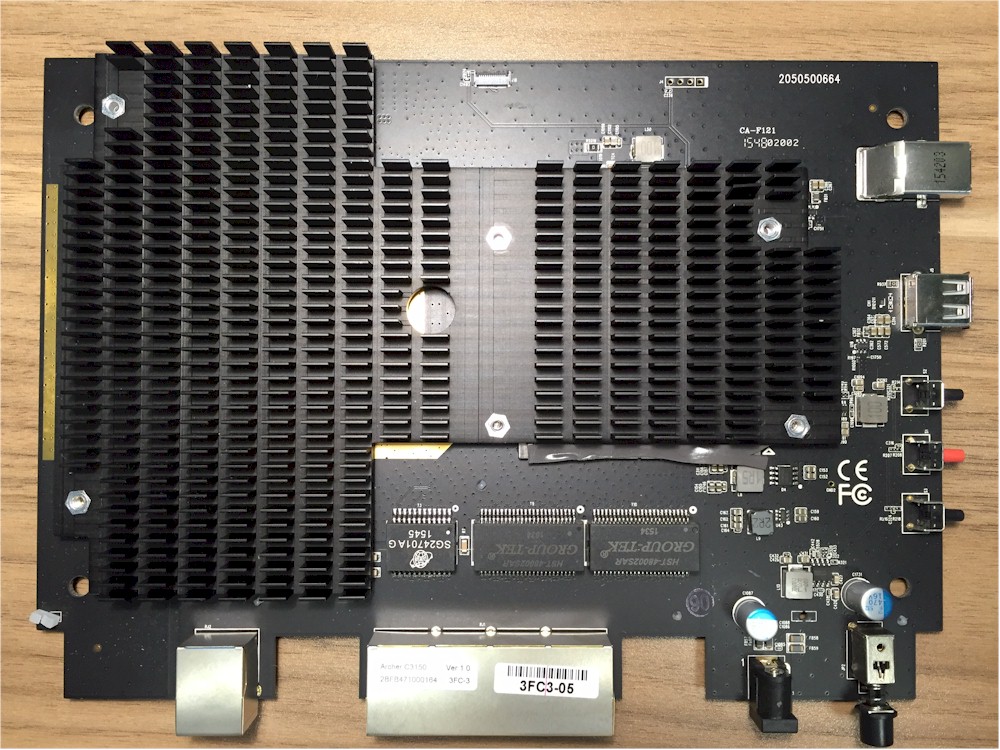
TP-LINK Archer C3150 board top w/ heatsink
Here’s a shot stripped down to the board. The Broadcom BCM4709C0KFEBG dual-core processor SoC is in the left side can, with its 256 MB of DDR3 RAM. The four-port Gigabit switch and WAN port are built into the SoC. The Broadcom BCM4366 4×4 radio SoCs are in the right side RF cans. The large copper area between them provides a large surface to thermally connect the RF amplifiers on the board bottom with the heatsink.
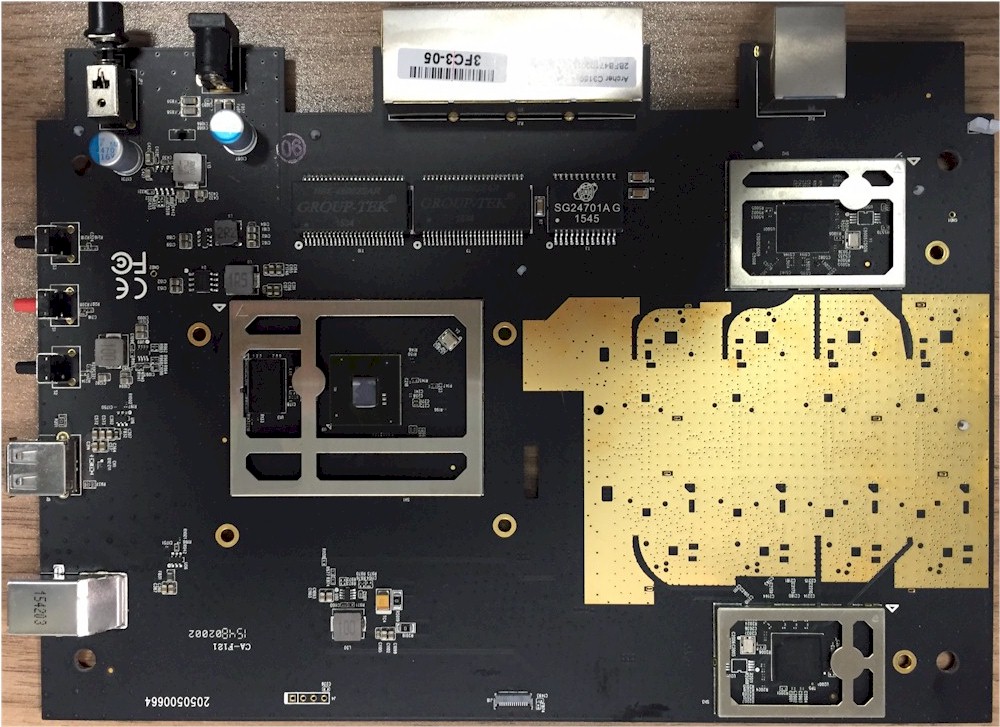
TP-LINK Archer C3150 board top
Here’s the bottom of the board, showing the flash above the left side RF can and the RF ampliers on the right; 2.4 GHz on top and 5 GHz below it.
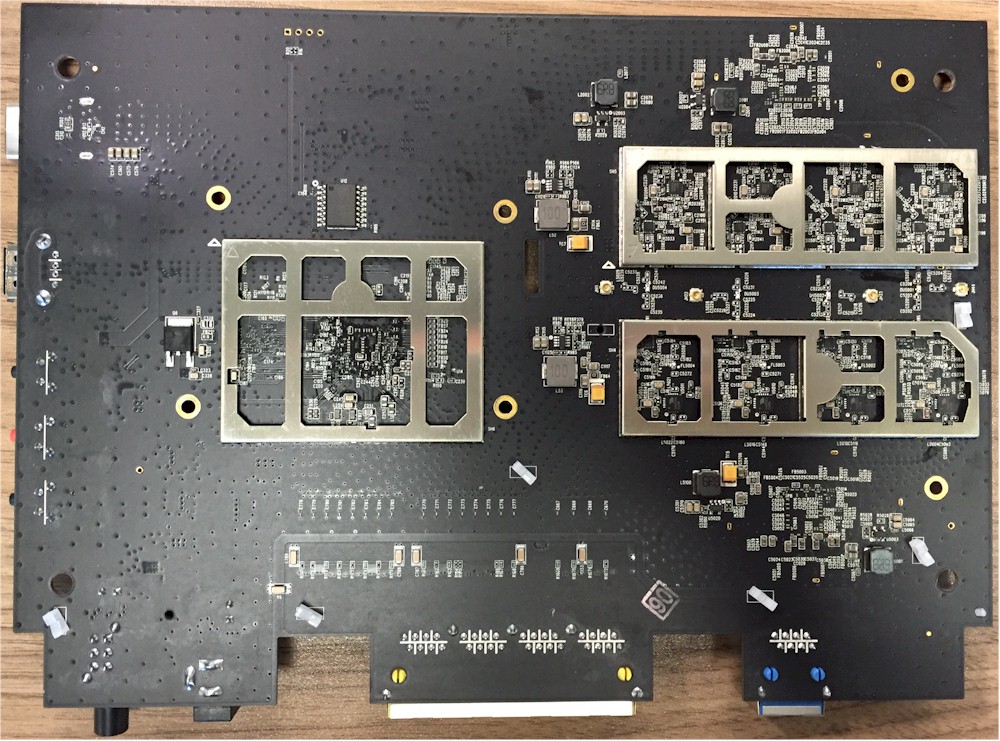
TP-LINK Archer C3150 bottom view
The C3150’s key components are in Table 1 along with ASUS’ RT-AC88U. Remember the AC88U has 8 Gigabit Ethernet LAN ports, hence the Realtek switch. The ASUS’ key advantage over the C3150 is double the RAM. If you’re considering the AC88U but want to spend around $20 less, remember the RT-AC3100 shares the same FCC ID (MSQ-RTGW00), so must have the same Wi-Fi performance characteristics.
| TP-LINK Archer C3150 | ASUS RT-AC88U | |
|---|---|---|
| CPU | Broadcom BCM4709C0KFEBG dual-core @ 1.4 GHz | Broadcom BCM4709C0KFEBG dual-core @ 1.4 GHz |
| Switch | In BCM4709C0KFEBG | 4 ports in BCM4709C0KFEBG + four ports in Realtek RTL8365MB |
| RAM | 256 MB | 512 MB |
| Flash | 128 MB (?) | 128 MB |
| 2.4 GHz Radio | – Broadcom BCM4366 4×4 2.4/5G single chip 802.11ac SoC – Skyworks SE2623L 2.4 GHz power amp (x4) – Skyworks SKY85201-11 2.4 GHz SPDT switch w/ LNA (x4) |
– Broadcom BCM4366 4×4 2.4/5G single chip 802.11ac SoC – Skyworks SE2623L 2.4 GHz power amp (x4) – Skyworks SKY85201-11 2.4 GHz SPDT switch w/ LNA (x4) |
| 5 GHz radio | – Broadcom BCM4366 4×4 2.4/5G single chip 802.11ac SoC – RFMD RFPA5542 5 GHz PA module (x4) – Skyworks SKY85605-11 5 GHz SPDT switch w/ LNA (x4) |
– Broadcom BCM4366 4×4 2.4/5G single chip 802.11ac SoC – RFMD RFPA5542 5 GHz PA module (x4) – Skyworks SKY85605-11 5 GHz SPDT switch w/ LNA (x4) |
Table 1: Component summary
Here’s a photo of the RT-AC88U’s inside. The Realtek switch is on the bottom of the board.
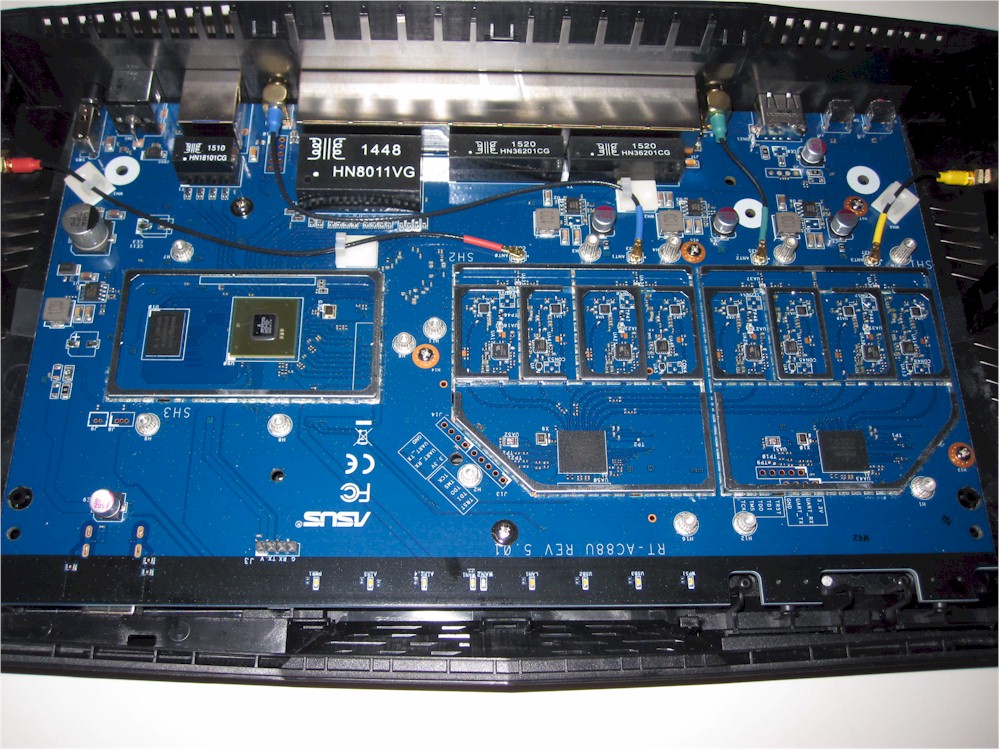
ASUS RT-AC88U board top
Features
The C3200’s admin GUI and feature set is basically the same as the Archer C2600 and C3200. Refer to this summary and use the online emulator to further explore features.
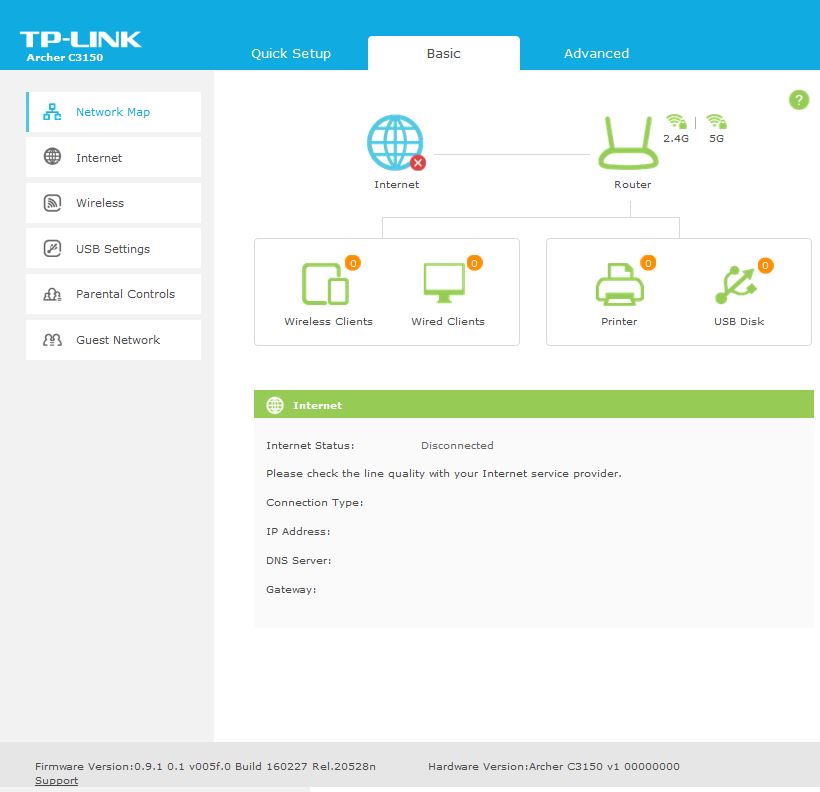
Basic mode status
The online simulator doesn’t reflect the latest firmware, however, and there are some changes. The screenshot below shows the Advanced > System Tools > System Parameters > Wireless Advanced screen for the 2.4 GHz radio. You’ll find the same screen for the 5 GHz radio, minus the USB 3.0 Interference Reduction checkbox. The Multi-User MIMO checkbox shouldn’t be shown in the 2.4 GHz screen. TP-LINK confirms it’s a bug and will have no effect on router performance.
The Airtime Fairness checkbox is nice to see, although I didn’t test it. If you have lots of older, slower devices along with 11ac devices, you might want to enable this and see if it helps speed up your faster devices.
Neither universal or WDS-based wireless bridging is supported.
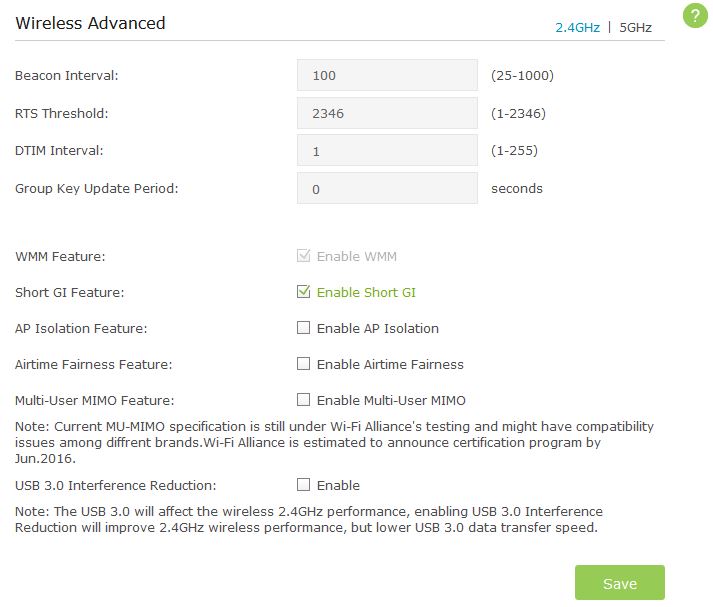
Wireless Advanced settings
Storage Performance
The summary graphic below from the Router Charts shows AC2600 and AC3100 / 3150 class routers we’ve tested with our standard procedure with USB 3.0 connections and NTFS drive format. The Linksys EA8500 remains the storage performance champ among all 4×4 routers we’ve tested. The Archer C3150 sits in the middle of the pack for both charts.
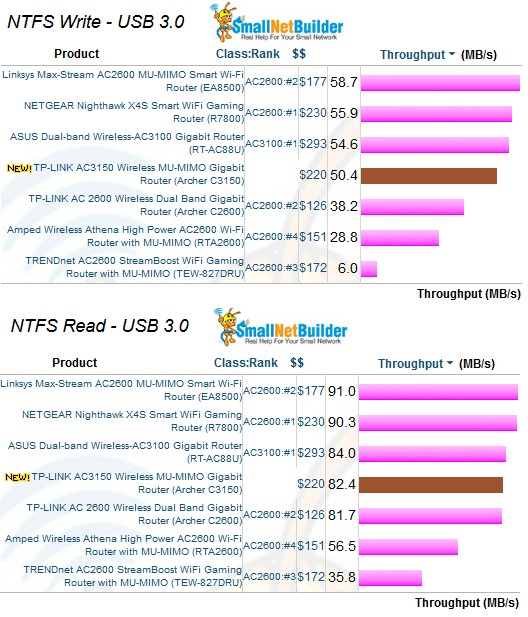
Storage Performance Comparison – USB 3.0 / NTFS
Routing Performance
The Archer C3150 was loaded with 0.9.1 0.1 v005f.0 Build 160707 Rel.64418n firmware and tested with our V4 router test process. You can download an Excel test summary that contains all functional and performance test results.
Table 2 summarizes the performance test results. Both TCP/IP and UDP unidirectional performance for all products are now typically near the limit of the CDRouter testbed. This QA Cafe article further explains CDRouter’s theoretical maximum application level throughput. The values include protocol overhead, which is why they’re lower than 1000 Mbps
| Test Description | TP-LINK Archer C3150 |
|---|---|
| WAN – LAN TCP (Mbps) | 941 |
| LAN – WAN TCP (Mbps) | 941 |
| Total Simultaneous TCP (Mbps) | 1628 |
| TCP Connection | Fail |
| WAN – LAN UDP (Mbps) | 382 |
| LAN – WAN UDP (Mbps) | 313 |
| Total Simultaneous UDP (Mbps) | 895 |
| UDP Connection | Fail |
Table 2: Routing performance comparison
Total Simultaneous TCP/IP throughput is proving to be a better performance differentiator. The highest performer so far for this test has been D-Link’s DIR-879 AC1900 EXO router at 1850 Mbps. Results for other products are shown in the bar chart below so you can get an idea of how the Archer C3150 does by comparison.
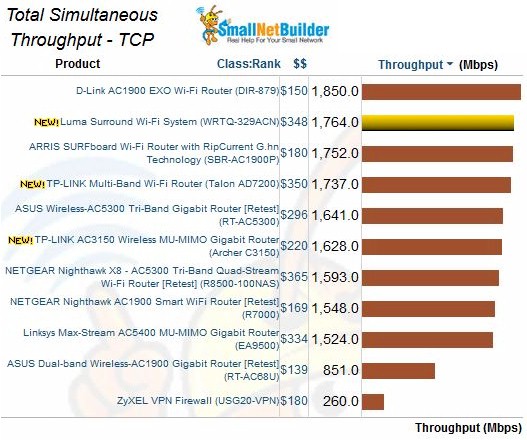
Total Simultaneous TCP/IP throughput comparison
Most products fail the new maximum UDP connection test and pass the TCP connection test. But the C3150 failed both, establishing only 86 out of 3000 TCP/IP connections. For UDP, it was able to establish all 3000 connections, but couldn’t keep them all open long enough (3 minutes) for the confirmation pass in the UDP test.
The Functional Score of 89.8% equates to 25 failed functional tests. In all, this is a decent score. The two largest groupings of failed tests were for UPnP and DNS functions related to the DHCP server.
As usual, some of the failed tests, such as HTTPs, fail because the router doesn’t support HTTPs administration. The CDRouter triggered port test, which I’ve set up to require a single port and port range to be opened, also failed because the router doesn’t allow the mix of ports in a single rule. Most routers fail this test because of similar restrictions on triggered port setup.
Wireless Performance
The Archer C3150 was tested with our Revision 9 wireless test process with 0.9.1 0.1 v005f.0 Build 160707 Rel.64418n version firmware loaded. Channel 6 and 20 MHz B/W mode was set for 2.4 GHz and Channel 40 and 80 MHz B/W mode was set for 5 GHz. The router was positioned in the test chamber as shown in the photo below. Note I propped up the rear of the router to bring the antennas into a straight-up vertical plane vs. their natural angled-back position.
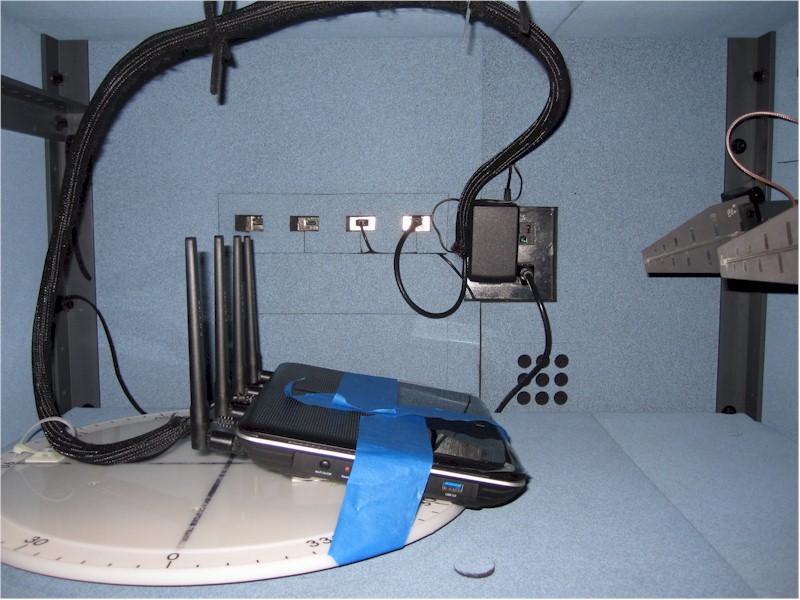
TP-LINK Archer C3150 in test chamber
The only other AC3100 / 3150 class router tested to date is the ASUS RT-AC88U. For fair comparison, I retested it with the V9 process and entered the data in the Charts.
The average 2.4 GHz throughput over all points measured is very similar in both downlink and uplink directions.
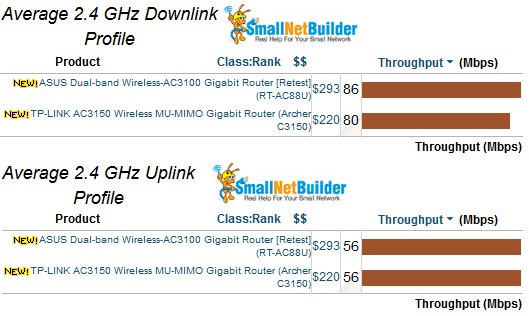
2.4 GHz average throughput comparison
5 GHz averages show more significant differences in both directions, with advantage going to TP-LINK.
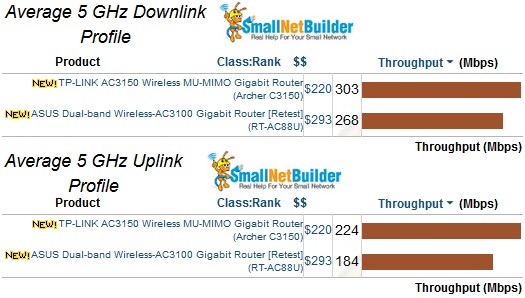
5 GHz average throughput comparison
Throughput vs. attenuation plots provide a more detailed look at wireless performance. The 2.4 GHz downlink plot shows the two products tracking very closely until the ASUS diverges at 54 dB of attenuation and drops connection at 57 dB. The TP-LINK stays connected 6 dB longer, indicating slightly better range.
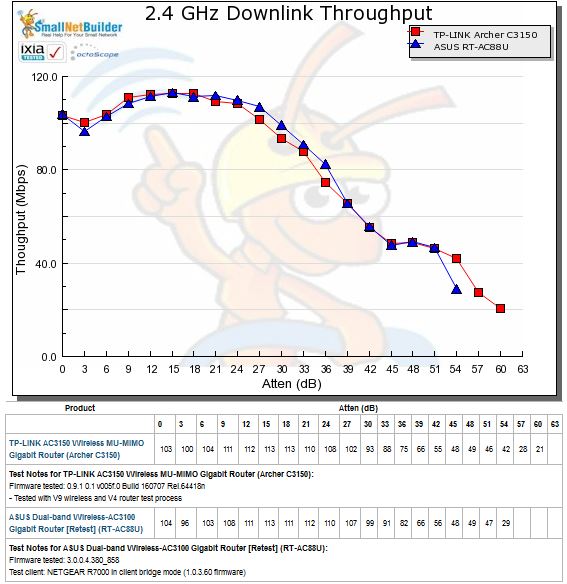
2.4 GHz Downlink Throughput vs. Attenuation
2.4 GHz uplink shows the two products closely tracking again, with a little separation starting at 30 dB of attenuation.
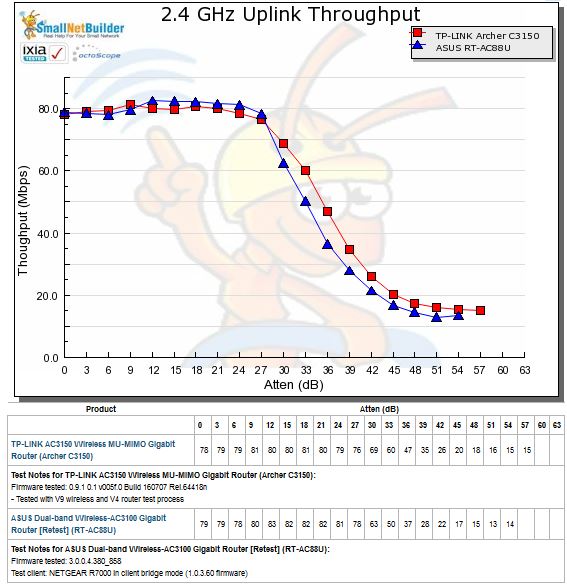
2.4 GHz Uplink Throughput vs. Attenuation
The 5 GHz downlink plots show similar profiles, but with the TP-LINK having generally higher throughput as signal levels drop (attenuation increases).
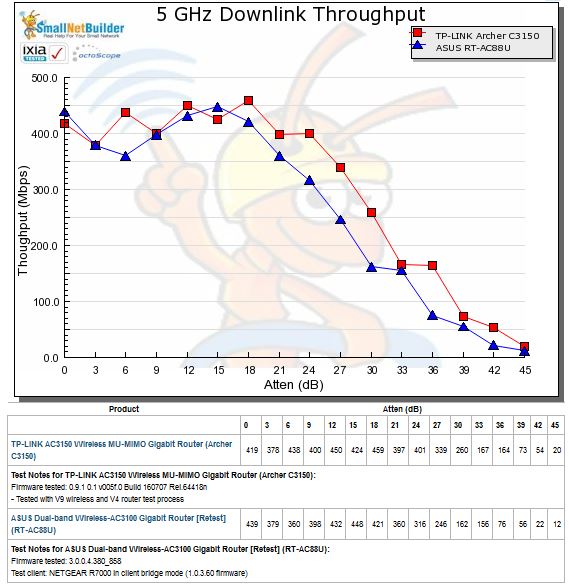
5 GHz Downlink Throughput vs. Attenuation
The C3150’s throughput exceeds the ASUS’ throughput most of the test range for 5 GHz uplink.
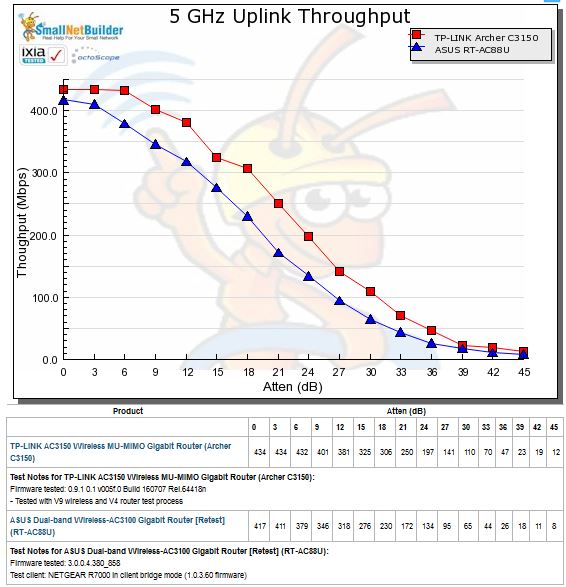
5 GHz Uplink Throughput vs. Attenuation
In all, these results show very similar performance in both bands, with the TP-LINK having a slight edge in 5 GHz.
Maximum Wireless Throughput
Since throughput vs. attenuation plots are now done with a 2×2 STA, we use the Ixia Veriwave that can emulate up to 4×4 ac devices. The results posted are an average of 10 one minute test runs. This benchmark is fully described in the Revision 9 test process description. We’re again comparing the C3150 with the ASUS RT-AC88U.
2.4 GHz results show the two products with essentially identical maximum throughput, both uplink and downlink. The products are again essentially the same for 5 GHz downlink. The only significant difference is in 5 GHz uplink, where the AC88U’s top throughput is about 90 Mbps higher than the C3150’s.
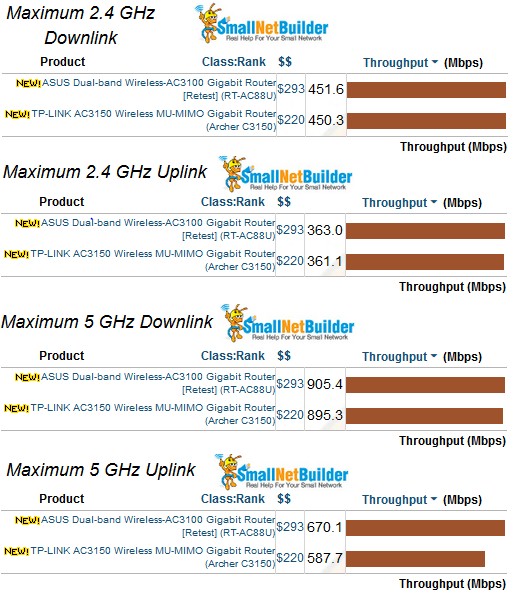
Maximum Wireless Throughput comparison
It’s interesting to note neither product would run the 5 GHz test at the maximum VHT MCS9 (1733 Mbps) rate. I had to drop the TP-LINK to MCS8 (1560 Mbps) and the ASUS to MCS7 (1300 Mbps). I’m not surprised by this. When I previously ran this test using a pair of the same router with one in bridge mode, I seldom would see them link at the maximum rate.
Why No Router Ranking?
With the major changes to our router test methodology, the ranking criteria also must change. Unfortunately, the current version of the Ranker supports only one set of ranking criteria per product class. We’re hard at work on a completely revamped Charts system that will support multiple sets of ranking criteria and test data that will make everything right again. Please bear with us in the meantime.
MU-MIMO Performance
The Linksys EA9500 review provided our first look at "working" MU-MIMO on a Broadcom-based product and the results were not pretty. The Linksys was able to muster only 151 Mbps of total throughput gain using MU-MIMO vs. throughput using SU-MIMO (normal) clients. So I didn’t expect much better from the Archer C3150.
The C3150 did even worse than the Linksys, showing no gain whatsoever from MU-MIMO operation. I ran the test multiple times with the same result.
The Veriwave system reports the number of MU frames used by each device, which is very helpful. The report with two MU devices connected showed each device using only 3% MU frames. When the number of MU devices increased to three, the MU frame percentage dropped to 0.002 and 0.003 for two of the devices, with the third using no MU frames at all. When the number of MU devices was increased beyond three, no MU frames were reported.
I shared these results with both TP-LINK and Veriwave for a sanity check before publishing this review. I have yet to see a Broadcom-based MU-MIMO product produce results anywhere near those from QCA-based products and wanted to know what their results showed. Unfortunately, I could not get data to confirm or refute my results from either source.
So at this point, I have to say that I can’t confirm whether the Archer C3150 has working MU-MIMO. I’ll update this review if I hear or can produce test results otherwise.
Closing Thoughts
Regular SmallNetBuilder readers know I don’t have high expectations for the practical benefit MU-MIMO will provide for most Wi-Fi users. The Archer C3150 does nothing to change my mind. When MU-MIMO works, it requires at least two devices, both with strong signals, to provide its benefit of higher total throughput. But most of us have yet to attach a single MU-MIMO device to our networks, let alone two. So buying a MU-MIMO router for the "benefit" of MU-MIMO or, worse yet, "future proofing", is an investment that may never pay off.
On the other hand, now that I’m testing with a 2×2 STA, our test results more accurately reflect what folks see from real-world devices. And it appears that 4×4 routers, no thanks to MU-MIMO, can push the throughput vs. attenuation (aka rate vs. range) curve above that of 3×3 AC1900 routers.
The plot below compares two AC1900 class routers—D-Link’s DIR-879 and NETGEAR’s R7000 original Nighthawk—with two 4×4 AC3100 / 3150 class routers—the Archer C3150 and ASUS RT-AC88U—tested with our standard 2×2 Intel AC client.
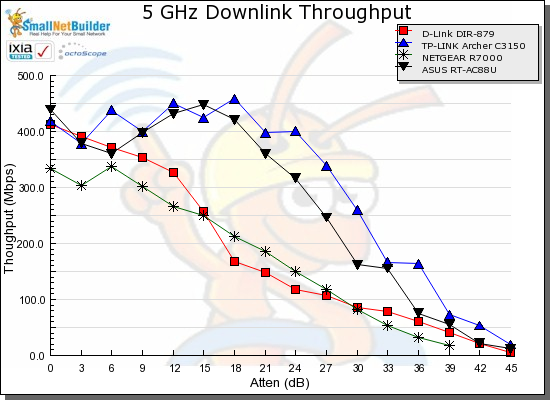
4×4 vs. 3×3 througput vs. attenuation
You can check all four plots and see results similar to the 5 GHz downlink plot above. These results suggest that upgrading to an 4×4 router might provide a benefit that has nothing to do with MU-MIMO, i.e. a throughput boost from the signal gain provided by more wireless streams. I hope to run another open-air study soon to see if these improvements occur outside the test chamber.
In the meantime, if you already have an AC2600 router, like the top-ranked NETGEAR R7800 or its #1 ranked predecessor, TP-LINK’s Archer C2600, there is no reason to move to the TP-LINK Archer C3150 or any AC3100 / 3150 router, including the more expensive ASUS’ RT-AC88U. Both are 4×4 routers that can provide the same rate vs. range improvement shown above. The AC3100’s higher number is there to suck in Wi-Fi noobs who don’t know better. The higher link rates require devices that support Broadcom’s proprietary 1024-QAM modultation in a 4×4 radio, which basically means another Broadcom-based 4×4 router in bridge mode.

 Buy AC3150 Wireless MU-MIMO Gigabit Router from Amazon
Buy AC3150 Wireless MU-MIMO Gigabit Router from Amazon